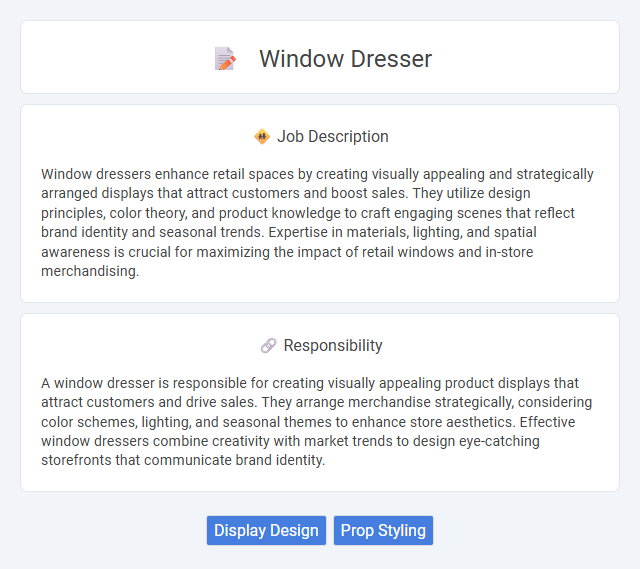
Window dressers enhance retail spaces by creating visually appealing and strategically arranged displays that attract customers and boost sales. They utilize design principles, color theory, and product knowledge to craft engaging scenes that reflect brand identity and seasonal trends. Expertise in materials, lighting, and spatial awareness is crucial for maximizing the impact of retail windows and in-store merchandising.
People with strong creativity and attention to detail are likely suitable for window dresser roles, as this job demands designing appealing and visually engaging displays. Individuals who enjoy working with aesthetics and have good spatial awareness probably find satisfaction and success in this profession. However, those who prefer routine tasks and minimal public interaction may find the job less suitable due to its dynamic and collaborative nature.
Qualification
Window dresser jobs require strong visual merchandising skills, creativity, and an eye for detail to design attractive and engaging displays that drive customer interest. Candidates typically need experience in retail or design, proficiency with design software, and an understanding of brand aesthetics and consumer behavior. Excellent communication and time management skills are essential for collaborating with store teams and meeting deadlines effectively.
Responsibility
A window dresser is responsible for creating visually appealing product displays that attract customers and drive sales. They arrange merchandise strategically, considering color schemes, lighting, and seasonal themes to enhance store aesthetics. Effective window dressers combine creativity with market trends to design eye-catching storefronts that communicate brand identity.
Benefit
Working as a window dresser likely offers the benefit of enhancing creative skills through designing visually appealing displays that attract customer attention. There is a strong probability of gaining experience in retail marketing strategies, which can improve understanding of consumer behavior. This role might also provide opportunities for collaboration with sales teams, potentially leading to improved communication and project management abilities.
Challenge
Window dresser jobs likely present significant challenges due to the need for creativity within strict brand guidelines and seasonal themes. The role probably demands balancing aesthetic appeal with practical considerations such as budget constraints and customer engagement. Success in this position may depend on the ability to quickly adapt and innovate under tight deadlines.
Career Advancement
Window dresser careers offer robust advancement opportunities through skill mastery in visual merchandising, design principles, and trend analysis. Progression often leads to senior roles such as Visual Merchandising Manager or Creative Director, focusing on strategic brand presentation and retail innovation. Specialized expertise in digital displays and customer psychology further enhances promotion prospects within competitive retail environments.
Key Terms
Display Design
Window dressers specialize in creating visually captivating displays that enhance retail store aesthetics and attract customer attention. Their expertise in display design incorporates color theory, lighting, and spatial arrangement to highlight products effectively and boost sales. Mastery in trend analysis and merchandising principles ensures that window displays align with brand identity and seasonal promotions.
Prop Styling
Window dresser jobs specializing in prop styling involve creatively selecting and arranging props to enhance visual storytelling and attract customer attention. Expertise in coordinating diverse materials, textures, and themes is essential to create compelling, on-brand displays that drive foot traffic and boost sales. Proven skills in spatial awareness and trend analysis enable prop stylists to transform retail environments into immersive, memorable shopping experiences.
 kuljobs.com
kuljobs.com